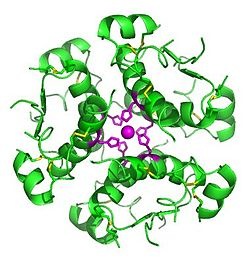I ♥ Proteins
 isbscience.org/news/2012/01/15/i-heart-proteins/
isbscience.org/news/2012/01/15/i-heart-proteins/
By Terry Farrah
Since I first learned about them as a college sophomore, protein molecules have been my scientific passion. I love them for the beauty of their shapes and functions. Protein molecules are central to the workings of life, but in popular culture they are the unsung hero next to their high profile cousin, DNA.
Everyone knows that DNA is the blueprint for life. But does one section of DNA directly encode the shape of your nose, another your talent on the dance floor, another your propensity for heart disease? If only it were so simple.
Actually, DNA is primarily a set of instructions for building about 20,000 different protein molecules. Each works as a tiny molecular machine with a very specific biochemical function. Many, many protein molecules work together in complex networks to produce your body parts, your talents, and your propensity for disease. These networks are very challenging to understand, which is why the sequencing of the genome hasn't yet led to a lot of medical breakthroughs.
In popular culture, protein is better known as an essential nutrient. This is because our bodies break down the protein we eat into its component amino acids, which are then used to build the new specific protein molecules that our bodies need. Whereas fats and carbohydrates serve primarily as energy sources, protein serves primarily as a source of amino acids for building other proteins.
Insulin, for example, is a protein molecule. When we consume sugar, insulin is secreted by the pancreas, whence it flows through the bloodstream as a messenger to tell the body to store that sugar as glycogen. Myosin is a protein molecule that works to contract muscles. Hemoglobin is a protein molecule; it grabs oxygen from the lungs and delivers it to the tissues. Lactase is a protein molecule; it breaks down milk sugars and if your body doesn't make enough lactase you are lactose intolerant. These are just a few of the 20,000 different protein molecules made by a human body. They operate by virtue of their exquisite shapes and subtle molecular properties; a few protein molecules are illustrated here.
As genomics is the study of the complement of DNA in a single organism (the genome), proteomics is the study of the collection of proteins in a single organism (the proteome). An enormous effort was expended at the end of the 20th century to sequence an entire single human genome. As enormous as that effort was, the effort needed to understand the proteome is much greater, and is still in its early stages.
We can create a draft proteome by reading the genome; this is how we estimate that there are about 20,000 human proteins encoded by the genome. However, those proteins are manufactured at different times, under different conditions, with different modifications, in different amounts, by different tissues at different stages of life. Understanding the effects of all these variables is critical to understanding how life works.
To address this critical need, we in the lab of Dr. Rob Moritz at ISB are continually developing proteomic technologies. In particular, we are working on methods for using a technology known as mass spectrometry (this video helps to put mass spectrometry in perspective) to report exactly which protein molecules exist in a given biological sample.
We are just now completing a massive milestone effort to synthesize several fragments (known as "peptides") of each of the 20,000 human proteins, and to measure each one in several different mass spectrometers. This provides a comprehensive database of results that can be used to design more effective proteomic analyses. The database is called SRMAtlas, where SRM stands for Selected Reaction Monitoring, a proteomic technology that allows highly sensitive detection of specific proteins. Watch for SRMAtlas in the news later this year when the results are published.
With SRMAtlas, scientists both here at ISB and at institutions around the world will more easily develop assays for specific small collections of proteins. For example, one might want an assay for 100 proteins related to Alzheimer's disease. One can then run a person's blood through this assay to determine which of these proteins is present, and in what quantities. This will facilitate disease research, and ultimately, we hope, lead to tools for early diagnosis and personalized treatment.
As work such as SRMAtlas yields really practical results, the public will become increasingly aware of the critical role of proteins in biology — a role that is every bit as complex and important as the role of DNA.
Watch this blog in coming months for more about proteins and the inside scoop on ISB's work in proteomics.
About Terry Farrah: Terry is a software developer in the Moritz lab at ISB. She was a double major in biochemistry and computer science at UC Berkeley, received her MS in Computer Science at the University of Washington, and worked at Immunex and ZymoGenetics before joining ISB in 2008. She loves proteins (both to eat and to study) and is also a member of ISB's editorial board.







